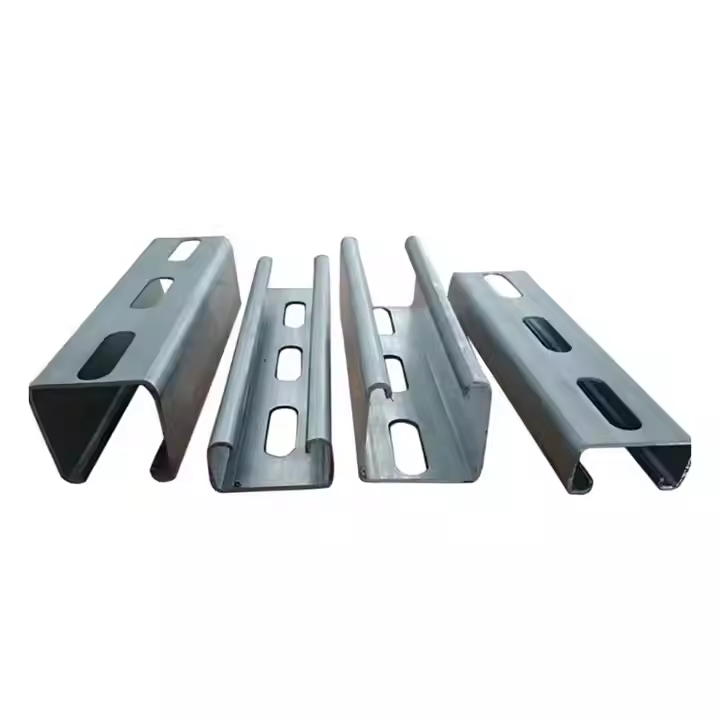As the demand for renewable energy continues to grow, photovoltaic (PV) systems have become a core part of sustainable power generation. A key component in ensuring the efficiency, stability, and durability of solar installations is the support structure. Among various materials available, Yuantai Runde zinc aluminum magnesium photovoltaic C-shaped steel stands out as one of the most reliable choices. Known for its high strength, corrosion resistance, and lightweight design, it is widely used in photovoltaic mounting systems, as well as in industries like construction, machinery, shipbuilding, and automotive manufacturing.

What Is Zinc Aluminum Magnesium Photovoltaic C-Shaped Steel?
Zinc aluminum magnesium photovoltaic C-shaped steel is a type of cold-formed steel with a C-shaped cross-section. Typically, it is produced by welding two steel plates together, forming a structural component that offers exceptional mechanical and physical properties.
This material is coated with a zinc-aluminum-magnesium alloy layer, which significantly enhances its corrosion resistance compared to traditional galvanized steel. The unique coating composition creates a protective barrier that performs exceptionally well even in harsh outdoor conditions, such as coastal or desert environments where PV systems are often installed.
Key Properties and Advantages
1. High Strength and Structural Stability
Zinc aluminum magnesium photovoltaic C-shaped steel offers excellent load-bearing capabilities. Its cold-formed manufacturing process improves mechanical strength, making it highly resistant to bending, compression, and torsion. This ensures the structural integrity of PV systems over decades of operation.
2. Superior Corrosion Resistance
The zinc-aluminum-magnesium coating offers advanced anti-corrosion performance, far surpassing traditional hot-dip galvanizing. This allows the steel to maintain its durability even in humid, salty, or high-pollution environments, reducing maintenance costs and extending service life.
3. Lightweight Yet Durable
Despite its strength, zinc aluminum magnesium photovoltaic C-shaped steel is lightweight, making it easier to handle and install. This reduces transportation costs, speeds up installation, and improves overall project efficiency without compromising structural safety.
4. Excellent Welding and Coating Performance
This material is highly adaptable for fabrication. Its good welding performance ensures strong, secure joints, while its surface coating adheres well to paint or other protective finishes, allowing for additional customization if required.
5. Long-Term Cost Savings
Because of its durability and low maintenance requirements, zinc aluminum magnesium photovoltaic C-shaped steel offers an excellent return on investment. PV projects benefit from reduced replacement frequency and lower repair expenses throughout the system’s lifecycle.
Applications in Photovoltaic Systems
In PV systems, zinc aluminum magnesium C-shaped steel is primarily used for:
-
PV Module Mounting Structures – providing stable support for solar panels in ground-mounted and rooftop systems.
-
Tracking System Frames – ensuring reliable movement and positioning in solar tracking applications.
-
Cable Management Supports – organizing and protecting electrical wiring within the PV array.
-
Structural Reinforcement – serving as crossbeams or braces to enhance overall system stability.
Its combination of high strength, corrosion resistance, and ease of processing makes it an ideal choice for these applications, especially in outdoor installations exposed to challenging weather.
Why It Outperforms Traditional Materials
Compared to standard carbon steel or aluminum profiles, zinc aluminum magnesium photovoltaic C-shaped steel delivers a superior balance of strength, weight, and corrosion resistance. While aluminum is lightweight, it lacks the structural rigidity required for large-scale PV projects. Carbon steel offers strength but often needs extensive corrosion protection. The zinc-aluminum-magnesium alloy coating bridges this gap, delivering both strength and long-term resistance to environmental degradation.
Sustainability and Environmental Benefits
Using zinc aluminum magnesium photovoltaic C-shaped steel also aligns with global sustainability goals. Its long service life reduces material waste, and its recyclability ensures minimal environmental impact at the end of its lifecycle. By extending the operational lifespan of PV structures, it helps maximize the environmental benefits of renewable energy systems.
Conclusion
For modern photovoltaic systems, the choice of support material is critical to ensuring long-term performance, safety, and cost-effectiveness. Zinc aluminum magnesium photovoltaic C-shaped steel combines strength, corrosion resistance, and ease of installation, making it the ideal choice for PV mounting structures. Its ability to withstand harsh conditions, maintain structural integrity, and reduce maintenance costs positions it as a leading material in the renewable energy sector.
Whether for utility-scale solar farms or commercial rooftop installations, this advanced material provides unmatched reliability and efficiency, helping to power the world with clean, sustainable energy.
www.yuantairunde.com
Baichuan Energy Co., Ltd.